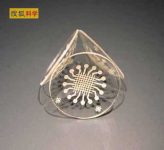
U.S. develops micro-RFID tags for smart contact lenses to transmit surveillance data
[ad_1]

Smart contact lenses can monitor glaucoma
According to the British “New Scientist” magazine, the University of California has developed a smart contact lens with a built-in pressure sensor, which can monitor conditions such as glaucoma. Scientists at the University of California in the United States have developed a new technology that can embed conductive circuits in the organic material lenses of conventional contact lenses, thereby creating the smart contact lenses.
Polydimethylsiloxane (PDMS) is a transparent, breathable, elastic organic material that can be molded into different shapes and is commonly used in contact lenses and breast augmentation materials. But the casting process severely limits the plastic shape of the material.
Now Hailin Chen and Tingrui Pan of the University of California have used a simple method to produce polydimethylsiloxane materials without the need for molds. They added a chemical to the polydimethylsiloxane liquid that caused the mixture to polymerize when exposed to ultraviolet light. They then irradiated the polymer with UV light through a circuit-patterned mask. This allows only the light-irradiated areas to polymerize, while the rest of the liquid can be completely washed away, leaving a trace of the circuit. This technique can be used to produce something as large as 10 microns.
In addition, they have also developed another technology that allows the polymer to have another property – electrical conductivity. The way to do this is to add a silver solution to this mixture, and as it polymerizes, the silver is trapped by it, forming a circuit that can be energized.
Since the electrical resistance of this circuit varies with how long the material is stretched, this modified polydimethylsiloxane is suitable for application in microelectromechanical systems. Pan Tingrui said that the polydimethylsiloxane produced by the new method can greatly expand the application of biosensor systems. The first device they made was a tiny pressure sensor that could be bent into the shape of a contact lens. This device measures pressure on the corneal surface and hydraulic pressure in the eye to monitor glaucoma and ocular hypertension. Pan Tingrui said that in patients with glaucoma, the pressure in the eye rises, which leads to deformation of the eye, which will also deform the contact lens sensor. “This change changes the resistance of this circuit, resulting in different resistance readings.”
A sample of the smart contact lens they developed (pictured) has an opaque sensor that reduces vision, so it should only be worn occasionally. But they’re making transparent sensors that can be worn for long periods of time and monitor eye pressure over time. They say wireless readings will be achieved through tiny RFID tags. This invention was published in the latest issue of “Advanced Functional Materials” magazine. (Yuan Yuan)
[ad_2]



